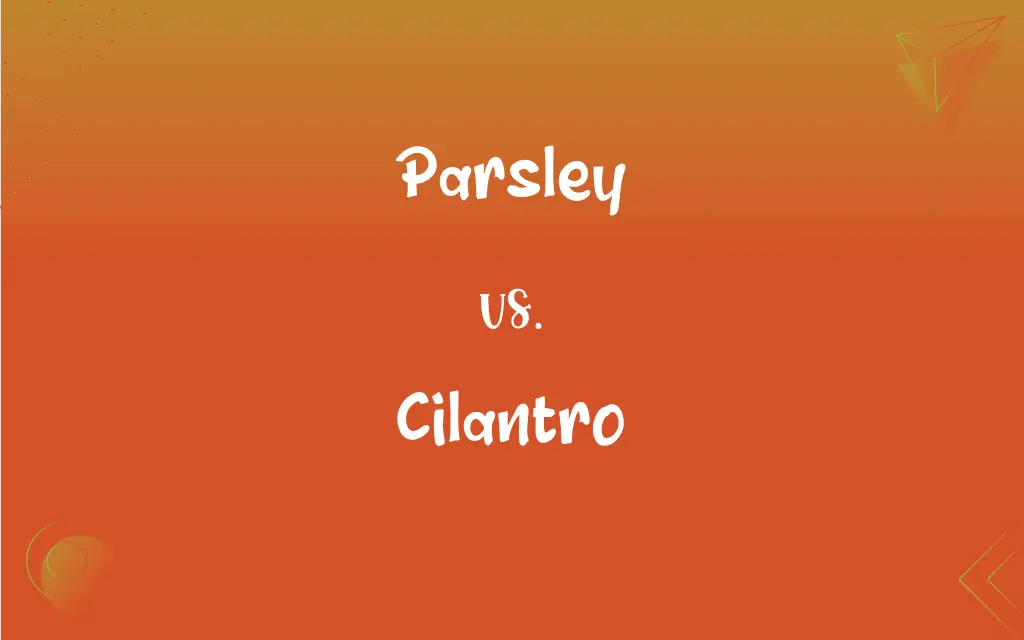Parsley vs. Cilantro: What's the Difference?
Edited by Janet White || By Harlon Moss || Updated on October 28, 2023
Parsley and cilantro are distinct herbs, with parsley having curled or flat leaves and a mild flavor, while cilantro has jagged leaves and a bold, citrusy taste.

Key Differences
Parsley often comes in two varieties: curly and flat-leaf (Italian). Its leaves are generally bright green, with a somewhat glossy finish. Cilantro, on the other hand, has jagged, tender leaves that resemble flat-leaf parsley but can easily be distinguished by its unique aroma.
Parsley has a mild, fresh flavor that doesn't overpower dishes and is often used as a garnish. Cilantro carries a bold, citrusy flavor, which is either loved or hated by many due to its distinct taste.
Parsley is versatile and can be used in a variety of dishes, including salads, sauces, and as a garnish. Cilantro is commonly used in Mexican, Asian, and Middle Eastern dishes, providing a zesty punch to salsas, curries, and more.
Parsley is native to the Mediterranean region and has been cultivated for over 2,000 years. Cilantro, also known as coriander in other parts of the world, originates from regions in Southern Europe, North Africa, and Southwest Asia.
Both parsley and cilantro come packed with nutrients. Parsley is rich in vitamins A, C, and K and contains antioxidants. Cilantro is known for its detoxifying properties and is also a good source of vitamins A, C, and K.
ADVERTISEMENT
Comparison Chart
Appearance
Bright green, glossy leaves that are either curly or flat
Jagged, tender leaves with a unique aroma
Taste
Mild, fresh flavor
Bold, citrusy flavor
Culinary Uses
Salads, sauces, garnishes
Salsas, curries, Asian/Mexican/Middle Eastern dishes
Origins
Mediterranean
Southern Europe, North Africa, Southwest Asia
Health Benefits
Rich in vitamins A, C, K and antioxidants
Detoxifying, good source of vitamins A, C, and K
ADVERTISEMENT
Parsley and Cilantro Definitions
Parsley
A culinary herb with curly or flat leaves.
She prefers flat-leaf parsley in her recipes for its robust flavor.
Cilantro
A staple ingredient in many Asian, Mexican, and Middle Eastern dishes.
Cilantro is essential for a flavorful pho broth.
Parsley
A traditional ingredient in tabbouleh and chimichurri sauce.
For authentic chimichurri, always add a good amount of parsley.
Cilantro
The leafy part of the coriander plant.
While some love the taste of cilantro, others find it soapy.
Parsley
A source of vitamins and minerals, often used in Mediterranean cuisine.
Parsley not only adds flavor but also provides nutritional benefits.
Cilantro
A plant that offers both edible leaves (cilantro) and seeds (coriander).
She uses cilantro in her salads and coriander in her curries.
Parsley
A green herb used primarily as a garnish or seasoning in food.
She sprinkled fresh parsley over the pasta for added flavor.
Cilantro
An aromatic herb with jagged leaves, used in various cuisines.
Cilantro adds a zesty touch to Mexican salsas.
Parsley
A biennial plant with white flowers and aromatic leaves.
Parsley plants thrive in her garden, blooming every two years.
Cilantro
An herb known for its bold and citrusy flavor.
The cilantro gave the dish a refreshing lift.
Parsley
A member of the parsley family.
Cilantro
The fresh stems and finely divided young leaves of the coriander plant, used in salads and various dishes as a flavoring and garnish. Also called Chinese parsley, coriander.
FAQs
How does cilantro taste?
Cilantro has a bold, citrusy flavor, which some people adore and others find similar to soap.
Can I substitute parsley for cilantro in recipes?
While both are herbs, they have distinct flavors; substituting might change the dish's taste.
Why do some people dislike cilantro?
Some have a genetic trait that makes cilantro taste soapy to them.
Which is more nutritious, parsley or cilantro?
Both are nutritious, offering vitamins A, C, and K, but they have different health benefits.
Is cilantro used in Italian cuisine?
Rarely, cilantro is more common in Mexican, Asian, and Middle Eastern dishes.
Can parsley help with bad breath?
Yes, parsley is known to act as a natural breath freshener.
Why is cilantro also called coriander?
In many parts of the world, the leaves are called cilantro, while the seeds are termed coriander.
Can I make tea with parsley?
Absolutely, parsley tea is an herbal drink known for its health benefits.
Are there any side effects to consuming too much cilantro?
Consuming excessive cilantro might lead to sensitivity in some people, but it's generally considered safe.
What is parsley?
Parsley is a green herb, used as a garnish or seasoning, with either curly or flat leaves.
What are the health benefits of parsley?
Parsley is rich in vitamins A, C, and K and has antioxidant properties.
How is dried parsley different from fresh?
Dried parsley is more concentrated but lacks the vibrant flavor of fresh parsley.
What's the best way to chop cilantro for a dish?
Use a sharp knife to coarsely chop cilantro, including tender stems, for maximum flavor.
How should I store fresh parsley?
Keep parsley in a water-filled jar in the refrigerator or wrapped in a damp paper towel in a plastic bag.
Is parsley used in tabbouleh?
Yes, parsley is a primary ingredient in tabbouleh, a Middle Eastern salad.
How can I grow cilantro at home?
Cilantro can be grown from seeds in well-draining soil, in a location with full sun to light shade.
How can I distinguish parsley from cilantro?
By appearance, they're similar, but their aromas are distinct, with cilantro being more pungent.
Is cilantro beneficial for detoxification?
Yes, cilantro is known to aid in the removal of heavy metals from the body.
Are parsley stems edible?
Yes, parsley stems are edible and flavorful.
What dishes typically use cilantro?
Cilantro is used in salsas, curries, pho, and many other Asian and Mexican dishes.
About Author
Written by
Harlon MossHarlon is a seasoned quality moderator and accomplished content writer for Difference Wiki. An alumnus of the prestigious University of California, he earned his degree in Computer Science. Leveraging his academic background, Harlon brings a meticulous and informed perspective to his work, ensuring content accuracy and excellence.
Edited by
Janet WhiteJanet White has been an esteemed writer and blogger for Difference Wiki. Holding a Master's degree in Science and Medical Journalism from the prestigious Boston University, she has consistently demonstrated her expertise and passion for her field. When she's not immersed in her work, Janet relishes her time exercising, delving into a good book, and cherishing moments with friends and family.































































